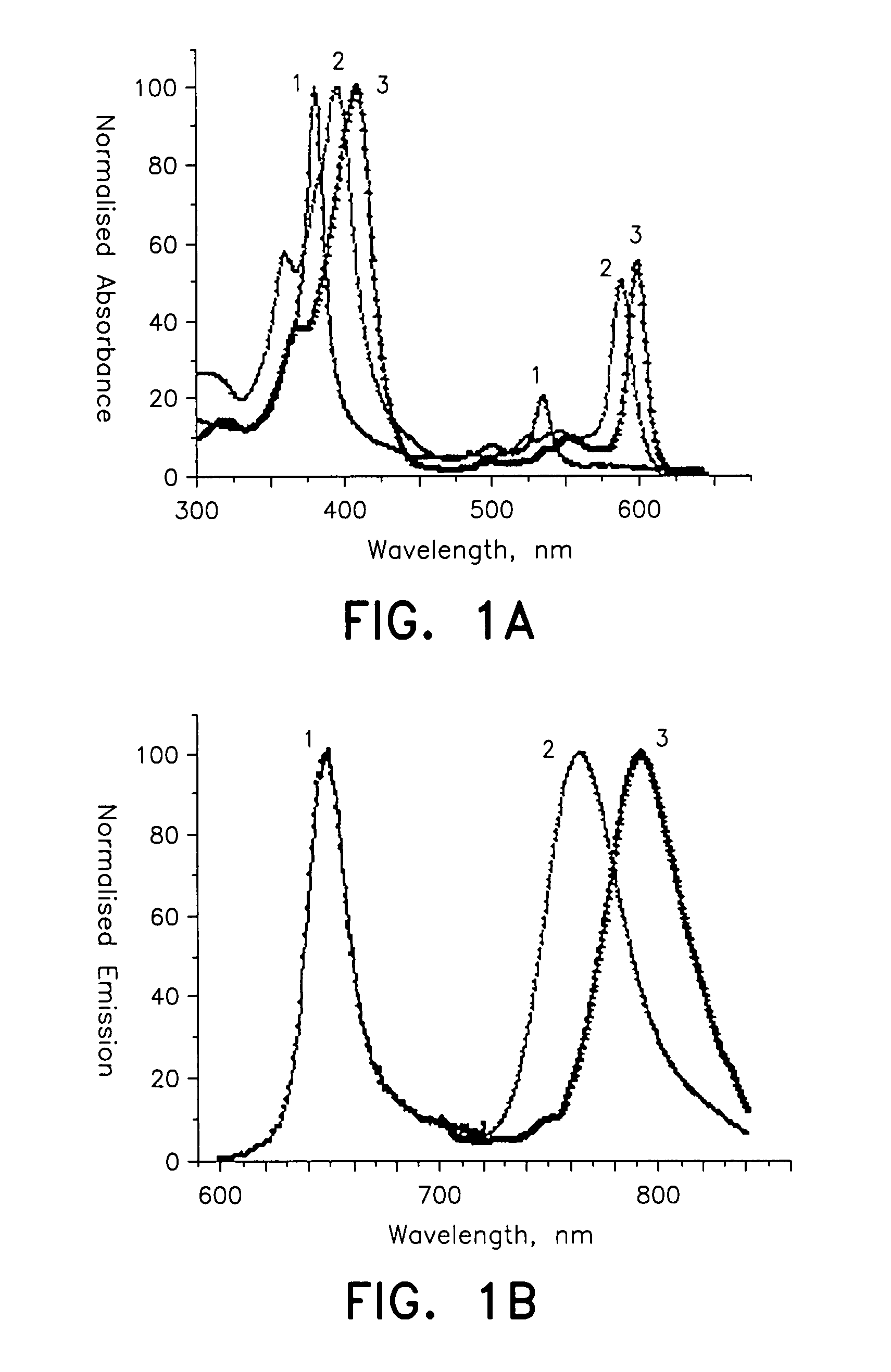Probe for cellular oxygen
- Summary
- Abstract
- Description
- Claims
- Application Information
AI Technical Summary
Benefits of technology
Problems solved by technology
Method used
Image
Examples
example 1
Fabrication of the PtCP Based Oxygen-Sensing Probe
[0083] PtCP-NCS dye was dissolved in DMSO to a concentration of 3 mg / ml (2.97 mM). 40 μl of this solution was added to 960 μl of bovine serum albumin in 0.05 M carbonate buffer, pH 9.6 and incubated for two hours at room temperature. The dye-BSA conjugate was separated from unbound dye on a PD10 desalting column in phosphate buffer saline. The conjugate fraction was collected and the concentration, and degree of labelling were determined from its absorption spectrum. The PtCP-BSA conjugate was dialyzed against water, lyophilized and stored dry at +4° C. for further use.
[0084] To produce the phosphorescent probe for intracellular oxygen sensing applications, the PtCP-BSA conjugate was dissolved in water at 100 μM solution. The intracellular oxygen probe was prepared by mixing 200 μl of serum free medium (RPMI) with 5 μl of Escort III transfection agent stock solution (Sigma) and 10 μl of the PtCP-BSA conjugate stock. For loading of ...
example 2
Fabrication of PtCPK and PdCPK Based Oxygen Probe
[0086] 0.5 mg of either PtCPK or PdCPK free acid were dissolved in 0.2 ml of dimethylformamide, mixed with 1 mg of EDAC carbodiimide and incubated 15 min at room temperature to activate the carboxylic groups of the dye. Activated PtCPK or PdCPK was then added to a solution of BSA (1 ml, 10 mg / ml) in 0.1 M Na borate buffer, pH 8.5, agitated for two hours at room temperature followed by purification of the dye—BSA conjugate on a PD-10 desalting column as described in Example 1.
[0087] Chemical composition and concentration of the conjugate (dye:protein ratio) were determined spectrophotometrically.
[0088] To produce the probe for intracellular oxygen sensing and imaging applications, the PtCPK-BSA or PdCPK-BSA conjugate was reconstituted in water at 100 μM concentration. 200 μl of serum free medium were mixed with 5 μl of Escort III transfection agent and with 10 μl of the conjugate stock (final concentration of the conjugate—5 μM). Fo...
example 3
Loading of Live Mammalian Cells with PtCP-BSA Based Probe and Measurement of Intracellular Oxygen Concentration on a Fluorescent Spectrometer
[0092] A549 and HeLa cells were cultured in 75 cm2 adherent cell flasks in DMEM supplemented with 10% FBS, 2 mM L-glutamine, 100 U / ml penicillin and 100 μg / ml streptomycin. 24 hours prior to loading, A549 cells were removed from the flask surface using PBS containing 2 mM EDTA and 1× trypsin, and aliquotted in 1 ml volumes into 35 mm glass bottom dishes (Mattek) or 10 mm round glass coverslips (Scientific Laboratory Supplies). Jurkat T-cells were grown in RPMI medium supplemented with 10% FBS, 2 mM L-glutamine, 100 U / ml penicillin and 100 μg / ml streptomycin.
[0093] For loading, the PtCP-BSA based probe comprising PtCP-BSA conjugate formulated with Escort III (described in Example 1) was used. Probe solution was pre-warmed by incubating at 37° C for 15 min followed by addition of 100 μl of the probe solution to the cell culture dish containing ...
PUM
| Property | Measurement | Unit |
|---|---|---|
| Temperature | aaaaa | aaaaa |
| Molar density | aaaaa | aaaaa |
| Time | aaaaa | aaaaa |
Abstract
Description
Claims
Application Information
 Login to View More
Login to View More - R&D
- Intellectual Property
- Life Sciences
- Materials
- Tech Scout
- Unparalleled Data Quality
- Higher Quality Content
- 60% Fewer Hallucinations
Browse by: Latest US Patents, China's latest patents, Technical Efficacy Thesaurus, Application Domain, Technology Topic, Popular Technical Reports.
© 2025 PatSnap. All rights reserved.Legal|Privacy policy|Modern Slavery Act Transparency Statement|Sitemap|About US| Contact US: help@patsnap.com



